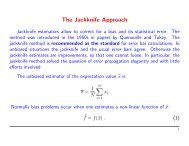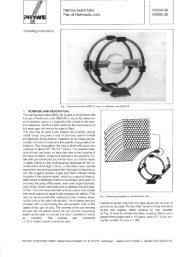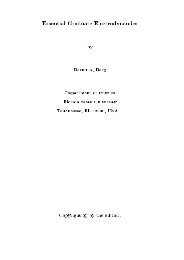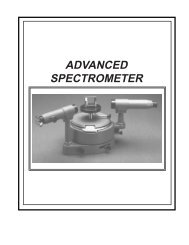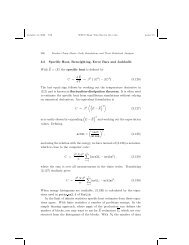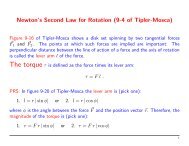MICROWAVE OPTICS - Granular Materials Laboratory
MICROWAVE OPTICS - Granular Materials Laboratory
MICROWAVE OPTICS - Granular Materials Laboratory
Create successful ePaper yourself
Turn your PDF publications into a flip-book with our unique Google optimized e-Paper software.
Microwave Optics012-04630F4 Set up the equipment as shown in Figure 5.4. Resetthe Receivers angle to 0-degrees (the horns shouldbe oriented as shown with the longer side horizontal).5Record the meter reading when the Polarizer is alignedat 0, 22.5, 45, 67.5 and 90-degrees with respect to thehorizontal.6 Remove the Polarizer slits. Rotate the Receiver so theaxis of its horn is at right angles to that of the Transmitter.Record the meter reading. Then replace the Polar-Figure 5.4 Equipment Setupizer slits and record the meter readings with the Polarizer slits horizontal, vertical, and at 45-Angle ofPolarizer0° (Horiz.)22.5°45°67.5°90° (Vert.)Meter ReadingAngle ofSlitsMeter ReadingHorizontalVertical45°degrees.Questions1 If the Receiver meter reading (M) were directly proportional to the electric field component(E) along its axis, the meter would read the relationship M = M ocosq (where q is the anglebetween the detector and Transmitter diodes and Mo is the meter reading when q = 0). (SeeFigure 5.2). Graph your data from step 2 of the experiment. On the same graph, plot therelationship M ocosq. Compare the two graphs.2 The intensity of a linearly polarized electromagnetic wave is directly proportional to the square ofthe electric field (e.g., I = kE 2 ). If the Receiver’s meter reading was directly proportional to theincident microwave’s intensity, the meter would read the relationship M = M ocos 2 q. Plot this relationshipon your graph from question 1. Based on your graphs, discuss the relationship between themeter reading of the Receiver and the polarization and magnitude of the incident microwave.3 Based on your data from step 5, how does the Polarizer affect the incident microwave?4 Can you explain the results of step 6 of the experiment. How can the insertion of an additional polarizerincrease the signal level at the detector? (ÿ HINT: Construct a diagram like that shown inFigure 5.2 showing (1) the wave from the Transmitter; (2) the wave after it passes through the Polarizer;and (3) the component detected at the detector diode.)20



